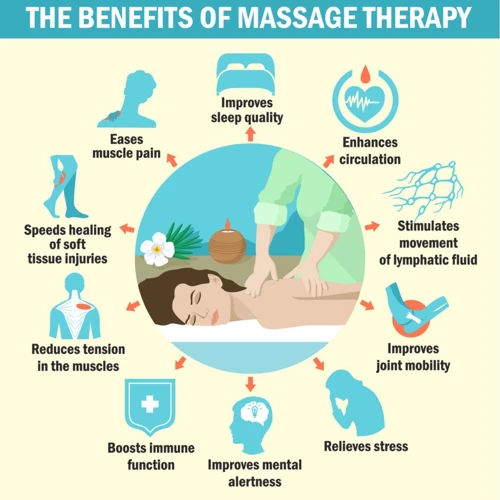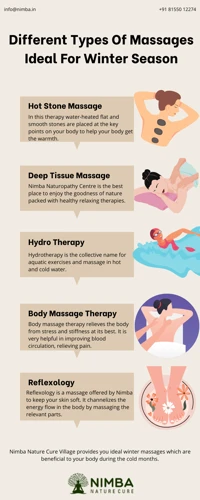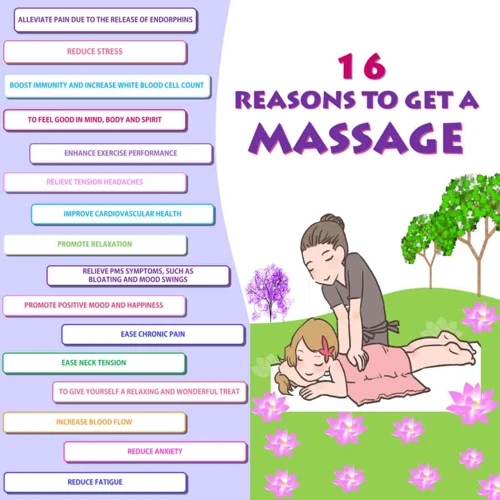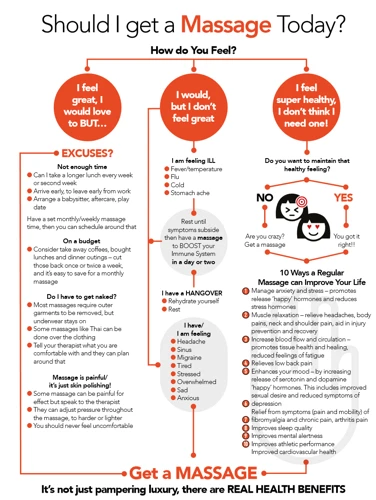Massage has been used for thousands of years to promote health and wellness. Whether you are looking for relief from physical pain or stress, or just want to pamper yourself, a massage can be a great way to relax and reap the benefits. But when is the best time to get a massage for maximum benefit? Read on to learn more about the best time to get a massage to reap its full benefits.
Contents
What are the Benefits of Massage?

Massage therapy offers a variety of physical and psychological benefits. It can reduce stress, improve circulation, reduce pain, and increase relaxation. It can also improve posture and reduce anxiety, depression, and insomnia. Massage can also help with muscle rehabilitation after an injury or surgery. The physical benefits of massage include improved circulation, increased flexibility, and improved joint mobility.
The psychological benefits of massage are just as important. Massage can help reduce stress, improve mood, reduce depression, and promote relaxation. It can also improve mental clarity and reduce feelings of anxiety. Massage can even help you to sleep better.
The benefits of massage don’t just stop there. Massage can also help with muscle recovery after a workout or injury. It can improve posture and reduce tension in the muscles. It can also help to reduce muscle pain, improve range of motion, and reduce inflammation.
When can I get a massage? The best time to get a massage is when you are feeling stressed or have tight muscles. You can also get a massage after a workout, to help with muscle recovery and reduce muscle soreness. If you are dealing with an injury or chronic pain, massage can help to reduce pain and improve mobility.
What are the Different Types of Massage?

Whether you’re looking for pain relief, improved circulation, or simply to relax, massage therapy has something to offer everyone. Massage therapy comes in a variety of forms, each with its own set of benefits and considerations. Depending on your needs and goals, a massage therapist can help you choose the right type of massage for maximum benefit.
Swedish Massage is the most popular and widely practiced form of massage therapy. It involves using long, light strokes, kneading, and friction techniques on the topmost layers of muscles to improve circulation, ease muscle tension, and promote relaxation.
Deep Tissue Massage is designed to target the deeper layers of muscle, tendons, and fascia. It is often used to ease chronic pain and tension, increase mobility, and reduce stress.
Sports Massage is used to treat injuries and enhance athletic performance. It focuses on specific areas of the body and utilizes techniques such as myofascial release and trigger point therapy.
Shiatsu Massage is a type of Japanese massage that uses finger pressure to stimulate points on the body and improve energy flow. This type of massage is often used to reduce stress, improve sleep, and increase relaxation.
Hot Stone Massage is a type of massage therapy that uses heated stones to relax the muscles and ease tension. The heat of the stones helps to increase circulation and focus the massage on specific areas of tension.
Prenatal Massage is specifically designed for pregnant women. It is used to reduce stress, ease muscle and joint tension, and improve circulation.
Trigger Point Massage focuses on areas of tightness, or trigger points, in the muscles. By applying pressure to these points, the massage therapist can help to reduce pain and increase mobility.
When deciding when to see a massage therapist, it’s important to consider your individual needs and goals. Talk to your massage therapist about the different types of massage and find out which one is best suited for your specific situation.
When to Get a Massage

After Physical Activity
Getting a massage after physical activity can help to reduce inflammation, reduce fatigue and lactic acid build-up, and decrease recovery time. It can also help to improve flexibility and range of motion of joints, as well as release tension.
To Relieve Stress
Massage can help to reduce stress levels by calming the nervous system and promoting a sense of relaxation. It can also reduce cortisol and adrenaline levels, which can help to reduce anxiety and depression, and improve mood.
To Alleviate Pain
Massage can help to relieve pain by improving circulation and helping to reduce inflammation and muscle tension. It can also help to release endorphins, which can help to reduce pain levels.
To Improve Sleep
Massage can help to improve sleep by helping to reduce stress and anxiety levels, as well as reduce cortisol and adrenaline levels. It can also help to relax the muscles, which can help to promote a deeper, more restful sleep.
To Boost Immunity
Massage can help to boost the immune system by helping to reduce stress and cortisol levels, which can help to improve overall health. Massage can also help to reduce inflammation and improve circulation, which can help to promote better health.
Who Should See a Massage Therapist?
- People with Chronic Pain: Massage therapy can help reduce chronic pain, improve mobility and reduce stress hormones.
- Athletes: Massage therapy can help athletes recover quickly from workouts and injuries and improve performance.
- People with Stress or Anxiety: Massage therapy can help reduce stress and anxiety, improve sleep quality and reduce muscle tension.
- People with Limited Mobility: Massage therapy can help improve mobility, reduce pain and improve range of motion.
- People with Low Energy Levels: Massage therapy can help increase energy levels, reduce fatigue and improve mental clarity.
When Can I Get a Massage?

Getting a massage can provide many benefits, but it’s important to know when is the best time to get one.
- Short-term relief: A massage can help alleviate soreness, pain and tension in the body. This can be especially helpful if you have been injured or are recovering from an illness.
- Regular treatments: Regular massages can help reduce stress, improve posture, and increase flexibility and range of motion.
- Long-term health: Massage is a great way to improve overall health and wellbeing. It can help reduce inflammation, strengthen the immune system, and improve sleep.
When it comes to getting a massage, there is no one-size-fits-all approach. It is important to consult with a qualified massage therapist to determine the best time for you to get a massage.
- Pain relief: If you have an injury or chronic pain, getting a massage can help provide relief. A massage can also help reduce inflammation and improve range of motion.
- Stress relief: Massage can help reduce stress and tension in the body. It can be especially helpful if you have a demanding job or lifestyle.
- Relaxation: Getting a massage can help you relax and recharge. It can also help improve your sleep and reduce fatigue.
The frequency of your massage treatments should be determined by your massage therapist. Generally, it is recommended that you get a massage at least once a month.
Considerations Before Getting a Massage
Health Status
Certain medical conditions may prevent you from getting a massage, so it is important to consult with your physician before making an appointment. Your doctor can let you know what type of massage is best for you and if there are any areas of the body that should not be massaged.
Budget
Massage therapy can be expensive. While the cost may seem high, massage can be a cost-effective form of healthcare. Many health insurance providers cover massage therapy, so it is important to check with your insurer to see if you are eligible for coverage.
Comfort Level
It is important to feel comfortable with the massage therapist. Ask for references or read reviews from other customers before booking an appointment. Research the types of massage available and decide which one is best for you.
How to Find a Massage Therapist
- Check Professional Credentials: When selecting a massage therapist, it is important to look for someone who is properly certified and licensed by the relevant governing body. Checking credentials will help ensure that your massage therapist has the necessary training, knowledge and experience to provide a safe and beneficial massage.
- Find Out About Different Types of Massage: Different massage therapists have different experience and specialties. It is important to research the types of massage available and find out which type of massage best suits your needs.
- Check References: Asking for references from previous clients is a good way to determine the quality of a massage therapist’s work. It is also a good idea to read online reviews and ratings from past clients.
- Consider Your Budget: Before selecting a massage therapist, it is important to consider your budget. Different massage therapists offer different rates, so it is important to find one that fits into your budget.
- Find Out About Insurance Coverage: Many insurance policies cover massage therapy services. It is important to find out if your insurance policy covers massage therapy and if your massage therapist is a provider.
- Schedule a Consultation: Before committing to a massage therapist, it is important to schedule an initial consultation. This will give you an opportunity to meet the therapist, discuss your goals and expectations, and ask any questions you may have.
Frequently Asked Questions
How Often Should I Get a Massage for Maximum Benefit?
- 1-2 Times a Week: Getting a massage 1-2 times a week can help relieve stress, reduce pain, and improve overall health and well-being.
- Monthly: Massage therapy can be beneficial to those with chronic pain, such as lower back pain, as well as people who are looking to improve their overall health. Scheduling a massage once a month can be beneficial for those with chronic pain, as it can reduce inflammation and improve range of motion.
- Seasonal: For those who don’t suffer from chronic pain or don’t need regular massage therapy, scheduling a massage once or twice a season can help with relaxation and can also help reduce stress and tension.
The frequency of massage therapy depends on the individual needs and goals of the person receiving it. It is important to discuss your goals and needs with your massage therapist to determine how often you should receive a massage for maximum benefit.
Is Massage Beneficial for Physical and Mental Health?
Massage is an effective tool for managing stress and improving both physical and mental health. Studies have found that massage helps reduce stress hormones, boost mood and immunity, and improve sleep quality. It can also reduce pain, improve circulation, and reduce muscle tension. Massage can also help improve mental clarity and concentration. Overall, massage can be an important part of overall health and wellness, helping to reduce stress and improve physical and mental wellbeing.
Are there any safety concerns to consider when getting a massage?
1. Hygiene – Massage therapists should wear gloves and use a massage oil or lotion that is free of fragrances, dyes, and preservatives. All surfaces, linens, and tools should be sanitized between sessions.
2. Communication – Massage therapists should provide a safe and comfortable environment and ask clients about any health concerns or medical conditions that may affect the massage. Clients should feel comfortable communicating their needs to the massage therapist.
3. Pressure – Pressure that is too strong can cause pain and discomfort. If the pressure is too light, the massage may not be effective. The massage therapist should adjust the pressure according to the client’s preference.
4. Boundaries – Massage therapists should respect the client’s privacy and personal boundaries. The massage therapist should not touch any areas of the body that are not discussed before the session begins.
5. Aftercare – After the massage, the client should drink plenty of water and avoid strenuous activities for a few hours. The client should also inform the massage therapist of any adverse reactions or changes in their health.
Are there any age restrictions for getting a massage?
No, there are no age restrictions. Massage therapy is suitable for people of all ages, including infants, children, and seniors. Massage therapy techniques can be adapted to suit the needs of each individual, regardless of age.
- Infants can benefit from massage therapy to help them relax, reduce stress, and improve their sleep patterns.
- Children can benefit from massage therapy to help them cope with physical and emotional stress, manage pain, and reduce anxiety.
- Seniors can benefit from massage therapy to help them manage pain, reduce stress, and improve mobility and flexibility.
It is important to consult with a qualified massage therapist to ensure that the massage is tailored to the needs and abilities of the individual. It is also important to be aware of any medical conditions that may need to be taken into account before the massage is given.
What should I look for when choosing a massage therapist?
Experience: The massage therapist should have relevant experience in the type of massage you require. Ask how long they have been practicing and any other relevant qualifications and certifications.
References: Ask for references or reviews from previous clients. A good massage therapist will have plenty of positive reviews from satisfied clients.
Price: Make sure to compare prices from different massage therapists to find the best deal. However, remember that the cheaper option may not always be the best option.
Location: Consider the location of the massage therapist. A convenient, easy-to-access location will make it easier to book appointments and attend them.
Services: Make sure the massage therapist offers the type of massage you need. Some massage therapists may specialize in certain types of massage such as deep tissue massage.
Communication: Look for a massage therapist who is willing to listen to your needs and work with you to create a treatment plan tailored to your individual needs. Good communication is key.
Trust: Look for a massage therapist who you feel comfortable with and who you can trust. The massage therapist should be professional and respectful.
Conclusion
Massage therapy offers a variety of physical and mental health benefits that are worth exploring. Regular massage sessions can help reduce stress, improve posture and flexibility, and even reduce chronic pain. Massage therapy can also help improve sleep, elevate mood, and increase relaxation. To get the most out of massage therapy and to enjoy its full range of benefits, it is important to talk to your healthcare provider to determine how often and when massage should be included in your health and wellness routine.

